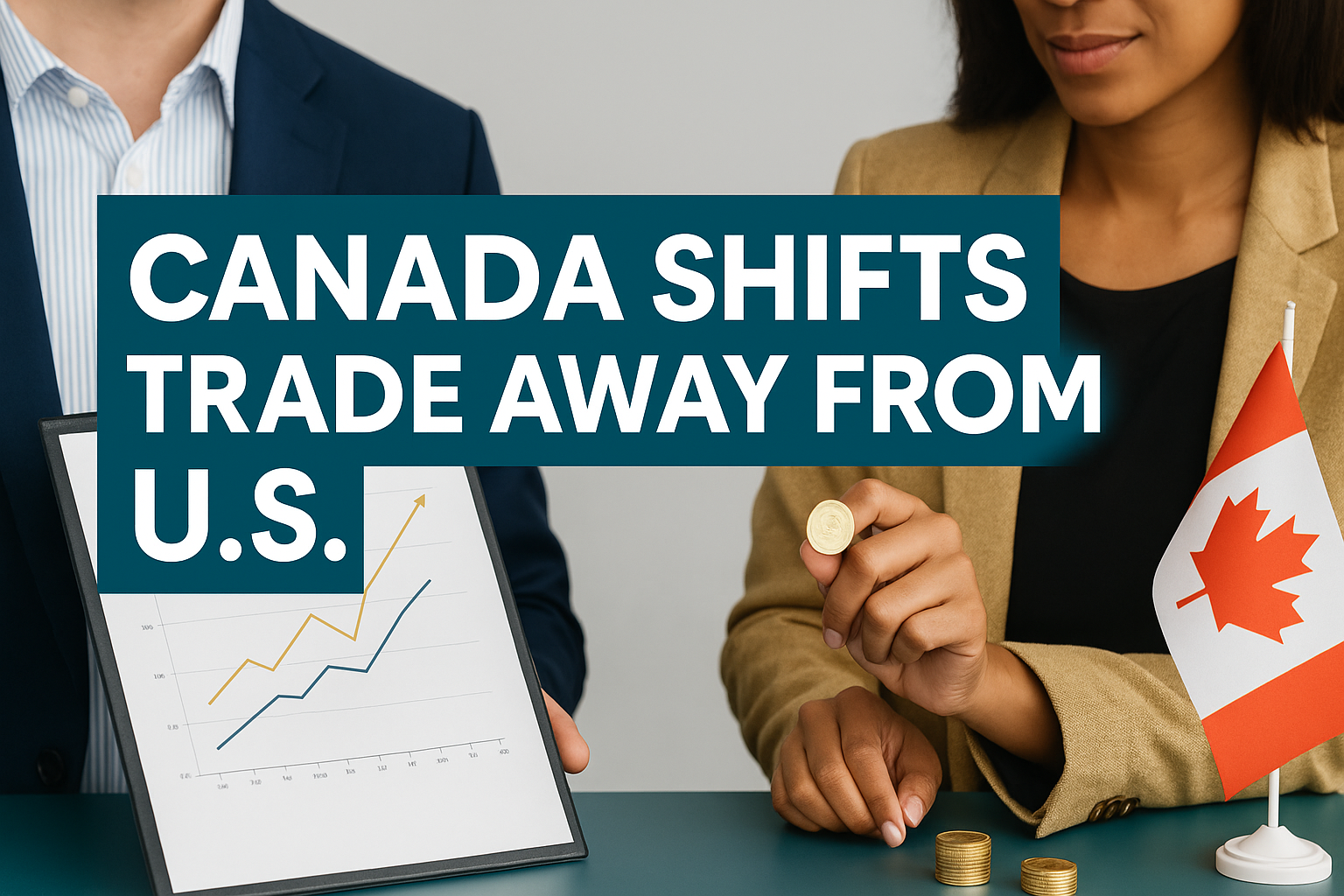Canadian Companies Shift Trade Away from U.S. to Dodge Trump Tariffs
Intermediate | July 17, 2025
✨ Read the article aloud on your own or repeat each paragraph after your tutor.
A New Direction for Canadian Trade
In response to rising tariffs, Canada shifts trade away from the U.S. in a bold effort to reduce dependency and build new partnerships.
Responding to U.S. Tariffs
Canadian companies are making a significant change in their trade strategy, moving away from relying heavily on the United States. This shift is a direct response to new tariffs imposed by the Trump administration, which began in early 2025. The goal is to reduce Canada’s long-standing economic dependence on its southern neighbor and spread its trade risks more broadly.
The First Tariffs and Escalation
The U.S. started with a 25% tariff on steel and aluminum imports in March 2025, followed by the same tariff on Canadian-made cars in April 2025.
There have also been threats of a larger 35% tariff on all Canadian imports by August 1, 2025. In return, Canada placed its own 25% tariffs on about C$29.8 billion worth of U.S. goods, including steel, aluminum, and certain vehicles, starting in March and April 2025.
This tit-for-tat escalation has heightened tensions, and businesses on both sides of the border are bracing for more uncertainty as the August deadline approaches.
The Impact and Response
Export Shifts and Economic Risks
This trade conflict has already shown clear effects. Between May 2024 and May 2025, Canadian exports to the U.S. dropped by 10 percentage points, now making up only 68% of Canada’s total exports. Specifically in March 2025, exports to the U.S. fell by 6.6%. On the other hand, Canadian exports to countries other than the U.S. saw a big increase of 24.8% in March 2025, one of the largest monthly rises ever recorded. Sectors like cars, car parts, steel, and aluminum have been hit hard, with exports of these products seeing significant declines in April 2025.
Costs on Both Sides of the Border
The tariffs also carry a high economic cost. Experts predict that if a 25% tariff were applied to all U.S. imports, Canada’s economy could shrink by 2.6% (about C\$78 billion) by mid-2025, costing each Canadian roughly \$1,900 annually. The U.S. economy would also suffer, potentially seeing a 1.6% reduction in its GDP. Furthermore, Canada has already experienced job losses, with manufacturing jobs decreasing by 55,000 since January 2025.
New Trade Routes and Infrastructure
Canada shifts trade away from U.S. markets by increasing exports to allied countries and investing in national infrastructure.
To counter these challenges, Canadian companies are actively seeking new trade partners. They are increasing trade with allies like the United Kingdom, European Union countries, Australia, and Japan, exporting more valuable goods such as gold, petroleum, uranium, and pharmaceuticals. The Canadian government, led by Prime Minister Mark Carney, is also investing in major infrastructure projects, including expanding ports and upgrading rail networks, to reorient trade flows. This includes a focus on energy transition infrastructure and critical minerals to boost export capacity.
Long-Term Strategy and Political Outlook
Prime Minister Carney’s government, elected in April 2025, is determined to lessen Canada’s economic reliance on the U.S. He has suggested that Canada might have to accept permanent tariffs on its exports to the U.S., with a 10% baseline tariff possibly being the best outcome. While goods compliant with the Canada-United States-Mexico Agreement (CUSMA) are mostly unaffected, economists warn that continuing to rely on non-U.S. markets may not be sustainable in the long term without even more significant infrastructure investments. The full economic impact of these tariffs is still unfolding.
Vocabulary
- Tariff (noun): A tax or duty to be paid on a particular class of imports or exports.
- Example: “The U.S. imposed a 25% tariff on steel imports from Canada.”
- Mitigate (verb): To make something less severe, serious, or painful.
- Example: “Canadian companies are shifting trade to mitigate the impact of tariffs.”
- Diversification (noun): The process of developing a wider range of products, markets, or investments.
- Example: “Strategic diversification aims to reduce Canada’s economic reliance on one country.”
- Retaliation (noun): The action of returning a military attack; counterattack.
- Example: “Canada implemented its own tariffs in retaliation for U.S. policies.”
- Surged (verb): Increased suddenly and powerfully.
- Example: “Canadian exports to countries outside the U.S. surged by 24.8%.”
- Contraction (noun): The process of becoming smaller.
- Example: “A 25% tariff could lead to a 2.6% contraction in Canada’s GDP.”
- Bolster (verb): To support or strengthen.
- Example: “Canada is developing critical minerals to bolster export capacity.”
- Stance (noun): A person’s posture or way of standing; an attitude or position on an issue.
- Example: “Prime Minister Carney’s political stance is to reduce U.S. economic dependence.”
- Exempt (adjective): Free from an obligation or liability imposed on others.
- Example: “Goods compliant with CUSMA are largely exempt from the broader tariffs.”
- Sustainable (adjective): Able to be maintained at a certain rate or level.
- Example: “Economists caution that relying on non-U.S. markets may not be sustainable without more investment.”
Discussion Questions (About the Article)
- What were the primary reasons Canadian companies started shifting their trade away from the U.S.?
- How did Canadian exports to the U.S. change between May 2024 and May 2025, and what happened to exports to other countries?
- Which sectors in Canada were most affected by the tariffs, and what was the impact on jobs?
- What infrastructure investments is Canada making to support its new trade strategy?
- What is Prime Minister Mark Carney’s view on Canada’s economic dependence on the U.S.?
Discussion Questions (About the Topic)
- Do you think trade disputes like this are good or bad for the global economy? Why?
- How might increased trade with diverse partners benefit a country like Canada in the long term?
- What are some challenges a country might face when trying to reduce its economic reliance on a major trading partner?
- If you were a Canadian business owner, how might these trade policies affect your decisions?
- How important is it for countries to have agreements like CUSMA to avoid trade conflicts?
Related Idiom
Put all your eggs in one basket
- Meaning: To risk everything by relying on only one thing to bring success.
- Example: “Canada is trying not to put all its eggs in one basket by diversifying its trade partners.”
📢 Want more tips like this? 👉 Sign up for the All About English Mastery Newsletter! Click here to join us!
Join the English Mastery Club — your place to practice, grow, and connect with others mastering English just like you!
Follow our YouTube Channel @All_About_English for more great insights and tips.
This article was inspired by: Reuters, July 9, 2025
SEO Details:
Focus Keyphrase: Canada shifts trade away from U.S.
SEO Title: Canada Shifts Trade Away from U.S. Amidst Tariffs
Slug: canadian-trade-shift-trump-tariffs
Meta Description: Canadian companies are shifting trade away from the U.S. to avoid Trump tariffs, marking a major shift as Canada shifts trade away from U.S.
Tags: Canada trade, US tariffs, economic diversification, Canadian economy, trade relations, Mark Carney, CUSMA,


